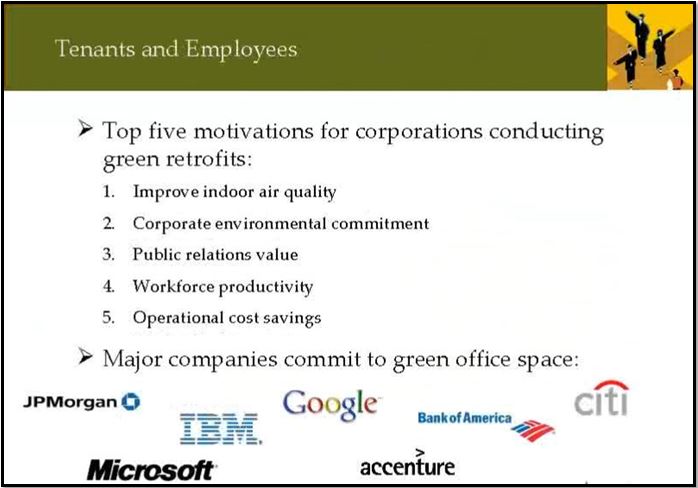By Steve Rizer
What are the top five motivations for corporations to conduct green retrofits and make their existing building space more environmentally friendly? The first such motivation that Nigel Hughes, an associate director for Navigant Consulting’s Real Estate Practice, revealed during a WPL Publishing webinar is a corporation’s desire to improve indoor air quality for its employees.
Number two is corporations’ environmental commitment to be a “green business,” Hughes said during “Existing Building and Stimulus: Cultivating Opportunities,” one of four 90-minute sessions comprising WPL’s Green Building Best Practices series and a webinar for which a recording recently was added to the ConstructionPro Network (ConstructionProNet.com) Download Library -- free of charge for members. Third, corporations committing to such retrofits “see the public-relations value in being green.”
Also motivating these corporations is a desire to improve worker productivity, Hughes said (see figure below). “It’s only when you get to number five on the list that actual direct dollars come into the operational cost savings of using less energy [and] using less water in a green space. Because of that, we’re seeing lots of major corporations, major companies commit to leasing only green office space, and that’s a great trend that’s continuing.”

In the figure below, Hughes provided a breakdown of the driving forces landlords and tenants to go green.

“The landlords’ regulatory changes are a major driver,” Hughes commented. “And these changes are the direct and indirect result of policies to tackle climate change and increase energy efficiency. Primarily, these changes will impact characteristics and locations in new buildings through development guidelines and more stringent building codes and ordinances. But in the future, these changes may also impact existing buildings.”
Hughes reported that regulators are using incentives to promote green buildings, such as expedited permitting and tax credits for renewable energy. “Further, policymakers are aiming to increase access to information that shows the greenness of buildings, so they’re mandating the release of energy usage and other building performance data. Landlords [are] also reacting to competitive pressure in the marketplace because they want to maintain the competitiveness of their buildings. This is one reason we’re seeing a strong surge in LEED registrations, for example, particularly in CBD locations, where, [regarding] existing Class A office space, it’s becoming apparent that green is the new Class A. If you’re not a green building, then essentially you’re not a Class A office.”
The tenants’ CSR reporting also is a very important driving force, Hughes said. “Major corporations have very much taken up sustainability reporting, and they need to be transparent in how they report energy usage [and] water usage in their buildings and other sustainability key performance indicators. New measurements, such as carbon footprint measuring, are also coming to the fore in this sort of non-financial reporting framework.”
Another important factor is portfolio optimization, “particularly in a down market,” according to Hughes. “Tenants are looking at maybe consolidating their operations in fewer locations, and sustainability may certainly be a key factor in the decisions they make about which locations they keep open and which ones they close.”
In addition to motivations, Hughes and Navigant Director Sean Ivery discussed activities, issues, and constraints for greening existing buildings, focusing on the following:
- The prevalence of Leadership in Energy and Environmental Design for Existing Buildings/Operation & Maintenance and other standards for existing buildings, such as Energy Star, GreenPoints, etc.
- Case studies of attempts to green existing leased space.
- Tools and methods that organizations are adopting to overcome the barriers to making their existing portfolios greener, including the Green Leasing Toolkit, developed by the California Sustainability Alliance.
For immediate access to the complete webinar (full audio and visual) -- as well as nearly three dozen other construction-related webinars that are available for download -- sign up to become a member of WPL Publishing’s ConstructionPro Network, a complete training, education, and development resource for the construction industry, at http://constructionpronet.com/info/Charter2012.aspx.

